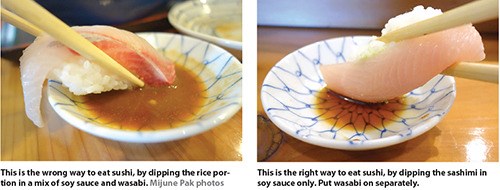Last week I wrote about the sushi basics and how to order it. Specifically, I focused on the differences between rolls (maki) and nigiri-zushi (nigiri). At traditional Japanese restaurants that serve good quality sushi, nigiri is what to order due to their simplicity. The sashimi the raw fish is the prize.
And now Part 2 the condiments.
At many Japanese restaurants it is standard to serve soy sauce with the sushi. However, at high-end Japanese restaurants the sushi chef might not even provide soy sauce, and asking for it would be equivalent to asking a Western chef for salt. At these upscale places the sushi chef will serve the sushi piece by piece and each nigiri will come seasoned with a brush of the chefs house-made soy sauce.
When the soy sauce is served with the sushi, do not dunk the sushi in it, or worse pour the soy sauce onto the sushi. This is not nachos and cheese. Please, stop with the soy. The sushi is meant to be dipped into the soy sauce, but not the whole thing. Only the sashimi is supposed to touch the soy sauce and never the rice, so flip the sushi upside down before you dip. Do not separate the fish from the rice either; doing so would ruin the sushi chefs art. Also, do not let the sashimi soak, or it will absorb too much soy sauce, masking the flavours of the fish. The sashimi is the whole point of sushi and it is a waste not to taste the freshness and quality of it. Soy sauce is not taboo, but use it sparingly.
As for the wasabi, do not mix it into the soy sauce and create a mucky paste. This is not art class. The wasabi is not meant to be mixed into the sauce. Sometimes it is already applied between the sushi rice and the fish by the chef, but sometimes it sits on the side as a condiment. If wasabi is desired, apply a touch of it on top of the fish. Rolling sushi in a paste of wasabi and soy sauce is like rolling a beautiful cut of steak in Tabasco.
Historically, wasabi was used to rid the bacteria in sashimi, but nowadays it is used to flavour the sushi. Some purists may argue it masks the flavour, or covers up poor quality fish, but others deem it as an enhancer. Wasabi opens up the palate and sinuses so that the flavours of the sashimi can be experienced at their full potential. There are many ways of looking at wasabi, but often, in Vancouver, the quality of wasabi is not even good enough to argue for or against it. If it is poor quality wasabi, it is always going to mask the sushi.
I mentioned this in Part 1, but a reminder the pickled ginger and radish side salad are the palate cleansers to eat between pieces of sushi, not toppings for the sushi.
Properly made good quality sushi does not require condiments. If the sushi chef is experienced, the sushi will come well seasoned and balanced without masking the flavours of the fish.
Recommendations for experiencing piece-by-piece sushi: Dan Sushi (2511 W. Broadway), Ajisai Sushi Bar (2081 W. 42nd), Minami (1118 Mainland), Octopus Garden (1995 Cornwall), and Ichiro Japanese (12011 2nd Ave. inRichmond).
Sushi 101 Part 3: How to eat sushi. Next week!
Find out more at FollowMeFoodie.com.



